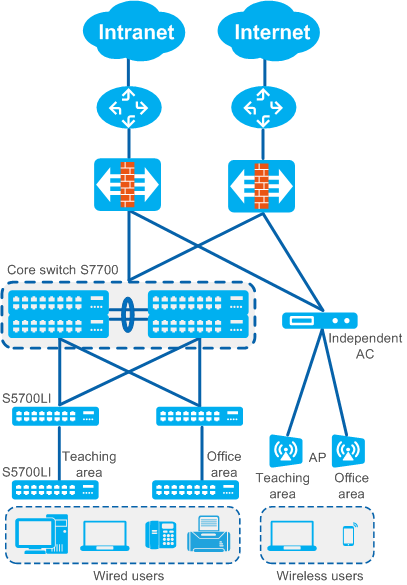Networking Requirements
Figure 1 shows the original network in the university's main campus. Core switches manage wired users, and independent ACs manage wireless users.
Users in different areas of the main campus can access the campus network and connect to the Internet through the campus network. Wired users use 802.1X authentication and wireless users use Web authentication to access the network.
The following figure shows only the network deployment for teaching and office areas. The network deployment for other areas is similar and is not shown in the figure.
- The network provides the Voice over Internet Protocol (VoIP), network printer, and multimedia services.
- Users in branch campuses can access the main campus network through the Intranet.
- Users outside the campuses can access the main campus network through the Internet.
The service deployment on the current campus network faces the following problems:
- As the population in the university grows, a large number of wireless users demand for wireless services. The wired and wireless networks are separately deployed and difficult to manage. The university demands for the wired and wireless convergence to simplify network management and improve network operation and maintenance (O&M) efficiency.
- As various network services develop in the campus and users need to access the network during moving, network information security becomes more important. The university desires the classification of access user roles to ensure that service policies and network experience are consistent wherever users go.
- The university has a large number of network devices and needs to frequently adjust network services. Network administrators need to modify configurations or upgrade versions on devices one by one to change a service, requiring heavy and trivial workload. The university desires the centralized configuration, management, and maintenance of network access devices.
- When a network fault occurs, network administrators cannot detect or troubleshoot it quickly, affecting user experience. The university needs a real-time network quality monitoring mechanism to reduce the impacts of network faults.
The university intends to deploy an agile network to simplify network deployment and configuration, improve user experience, and improve O&M efficiency.
